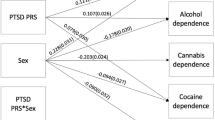Abstract
The well-documented association between combat-related PTSD (C-PTSD) and other mental disorders may be an artifact of shared familial vulnerability. This study uses a co-twin control design to examine whether the association between C-PTSD and other mental disorders persists after adjusting for shared familial vulnerability. Data were from male monozygotic twin pairs in the Vietnam Era Twin Registry. Logistic regression analyses demonstrated that combat exposure, adjusted for C-PTSD, was significantly associated with increased risk for alcohol and cannabis dependence and that C-PTSD mediated the association between combat exposure and both major depression and tobacco dependence. We conclude C-PTSD comorbidity persists after controlling for shared vulnerability. Combat exposure is directly and indirectly, through C-PTSD, associated with increased risk for other mental disorders.
Similar content being viewed by others
References
American Psychiatric Association. (1987). Diagnostic and statistical manual of mental disorders (3rd ed., Rev.). Washington, DC: Authors.
Beckham, J. C. (1999). Smoking and anxiety in combat veterans with chronic posttraumatic stress disorder: A review. Journal of Psychoactive Drugs, 31, 103–110.
Breslau, N., Davis, G. C., Peterson, E. L., & Schultz, L. R. (2000). A second look at comorbidity in victims of trauma: The posttraumatic stress disorder-major depression connection. Biological Psychiatry, 48, 902–909.
Breslow, N. E., & Day, N. E. (1980). Statistical methods in cancer research, 1. The analysis of case-control studies. Lyon, France: International Agency for Research on Cancer.
Chilcoat, H. D., & Breslau, N. (1998). Posttraumatic stress disorder and drug disorders: Testing causal pathways. Archives of General Psychiatry, 55, 913–917.
Cohen, J. (1977). Statistical power analysis for the behavioral sciences (Rev.). New York: Academic Press.
Eisen, S., Neuman, R., Goldberg, J., Rice, J., & True, W. (1989). Determining zygosity in the Vietnam Era Twin Registry: An approach using questionnaire. Clinical Genetics, 35, 423–432.
Eisen, S., True, W., Goldberg, J., Henderson, W., & Robinette, C. D. (1987). The Vietnam Era Twin Registry: Method of construction. Acta Geneticae Medicae Et Gemellologiae, 36, 61–66.
Henderson, W. T., Eisen, S., Goldberg, J., True, W., Barnes, J. T., & Vitek, M. E. (1990). Vietnam era twin registry: A resource for medical research. Public Health Report, 105, 368–373.
Janes, G. R., Goldberg, J., Eisen, S. A., True, W. R., & Henderson, W. G. (1992). Reliability and validity of a combat exposure index for Vietnam era veterans. Journal of Clinical Psychology, 47, 80–86.
Keane, T. M., & Wolfe, J. (1990). Comorbidity in posttraumatic stress disorder: An analysis of community and clinical studies. Journal of Applied Social Psychology, 20, 1776–1788.
Kendler, K. S., Bulik, C. M., Silberg, J., Hettema, J. M., Myers, J., & Prescott, C. A. (2000). Childhood sexual abuse and adult psychiatric and substance use disorders in women. Archives of General Psychiatry, 57, 953–959.
Kessler, R. C., Sonnega, A., Bromet, E., Hughes, M., & Nelson, C. (1995). Posttraumatic stress disorder in the National Comorbidity Survey. Archives of General Psychiatry, 52, 1048–1060.
Koenen, K. C., Harney, R., Lyons, M. J., Wolfe, J., Simpson, J., Goldberg, J., et al. (2002). A twin registry study of familial and individual risk factors for trauma exposure and posttraumatic stress disorder. Journal of Nervous and Mental Disease, 190, 209–218.
Kulka, R. A., Schlenger, W. E., Fairbank, J. A., Hough, R. L., Jordan, B. K., Marmar, C. R., et al. (1990). Trauma and the Vietnam War generation: Report of the findings from the national Vietnam veterans readjustment study. New York: Brunner/Mazel.
Mellman, T. A., Randolph, C. A., Brawman-Mintzer, O., Flores, L. P., & Milanes, F. J. (1992). Phenomenology and course of psychiatric disorders associated with combat related posttraumatic stress disorder. American Journal of Psychiatry, 149, 1568–1574.
Robins, L. N., Helzer, J. E., Cottler, L., & Goldring, E. (1988). National Institute of Mental Health Diagnostic Interview Schedule Version III—revised. St. Louis, MO: Department of Psychiatry, Washington University.
Rothman, K. J. (2002). Epidemiology: An introduction. New York: Oxford University Press.
Xian, H., Chantarujikapong, S. I., Shrerrer, J. F., Eisen, S. A., Lyons, M. J., Goldberg, J., et al. (2000). Genetic and environmental influences on posttraumatic stress disorder, alcohol and drug dependence in twin pairs. Drug and Alcohol Dependence, 61, 95–102.
Author information
Authors and Affiliations
Corresponding author
About this article
Cite this article
Koenen, K.C., Lyons, M.J., Goldberg, J. et al. Co-Twin Control Study of Relationships Among Combat Exposure, Combat-Related PTSD, and Other Mental Disorders. J Trauma Stress 16, 433–438 (2003). https://doi.org/10.1023/A:1025786925483
Issue Date:
DOI: https://doi.org/10.1023/A:1025786925483




